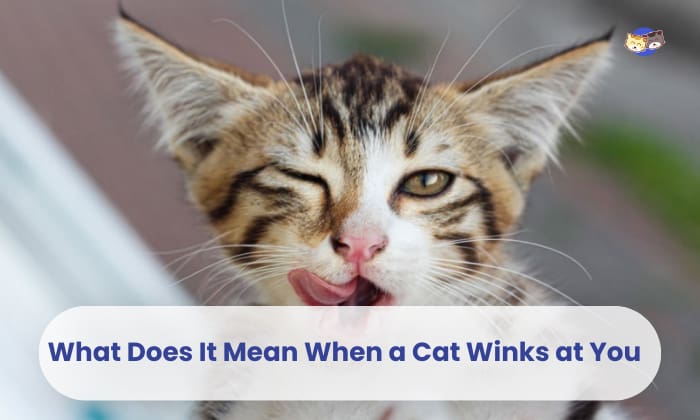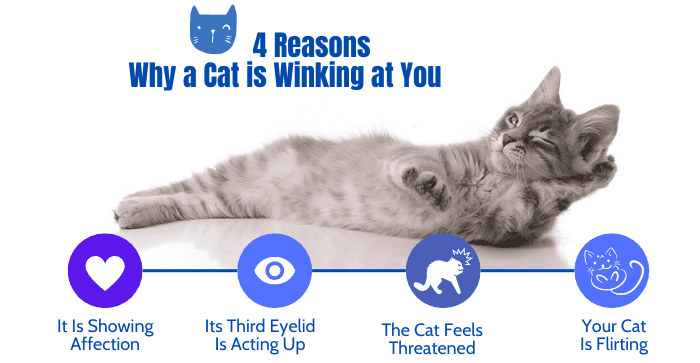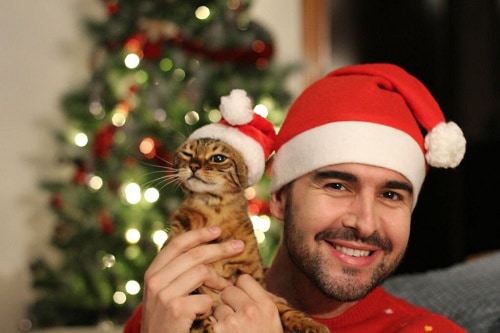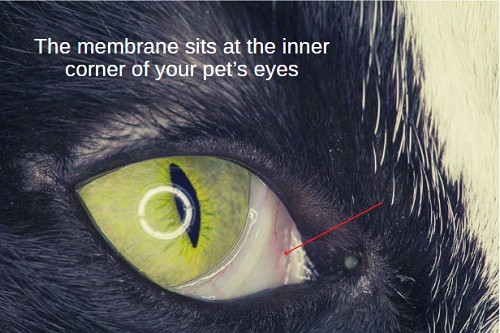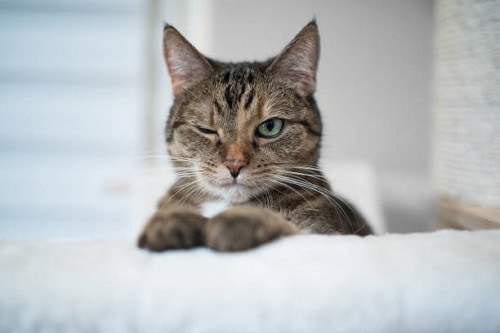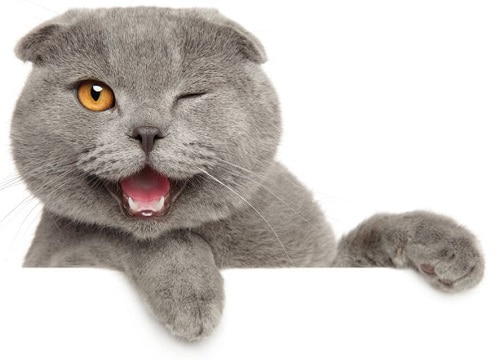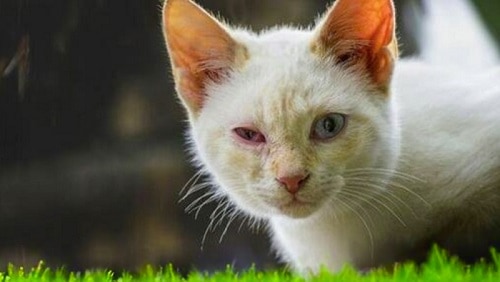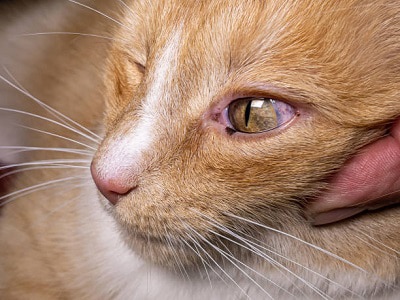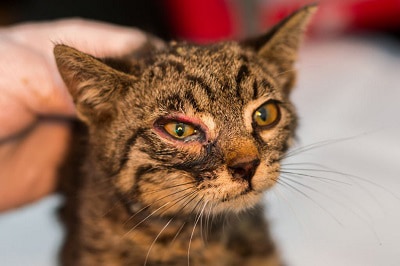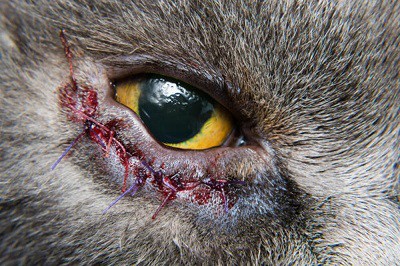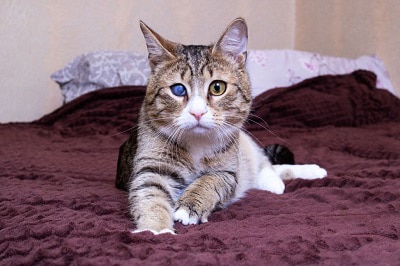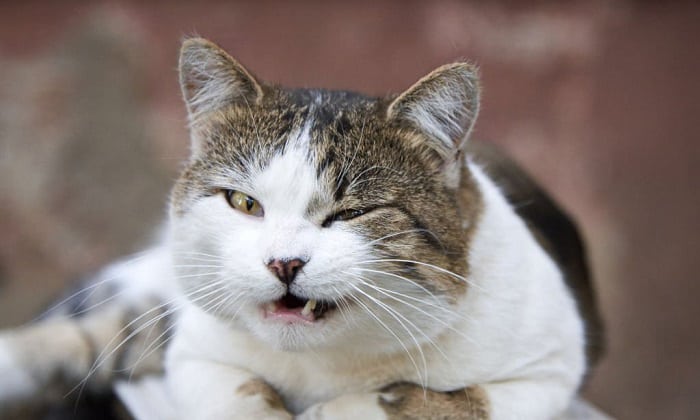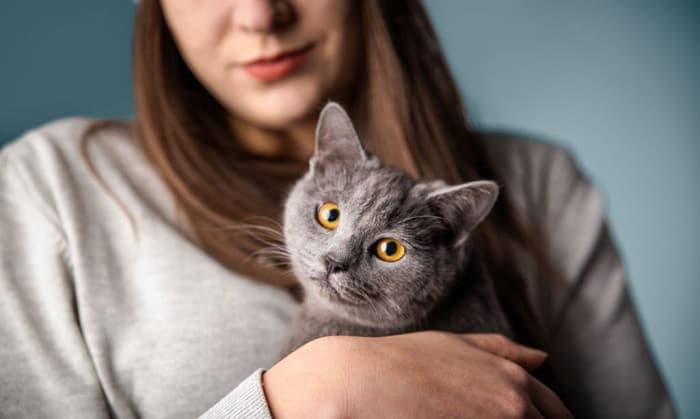One of the most adorable things cats do is when they wink at their caretakers. You may have already seen your pet do this a few times.
But have you ever wondered, “What does it mean when a cat winks at you?”
One reason why you may see a kitten winking is it’s showing its contentment and affection—winking means that your pet trusts you.
But if a cat keeps winking, it could also mean it feels discomfort in either eye.
Table of Contents
Why Does My Cat Wink at Me?
There are two ways felines blink. The first and most common is when they blink with both eyes, closing them slowly.
The second way of feline winking is when you see your cat blinking one eye. Both can have the same meaning.
Below are the most common reasons why a cat is winking at you:
1. It Is Showing Affection
Winking is not a common cat behavior. However, your pet may use this action to express affection towards you.
Felines tend to be aloof, even to their caretakers. So, if a cat winks at you, it only means you have gained its trust.
2. Its Third Eyelid Is Acting Up
Felines have a nictitating membrane, which acts as their third eyelid. This membrane sits at the inner corner of your pet’s eyes, moving diagonally across them to keep them moist.
In addition, the nictitating membrane is almost transparent, so felines can still see even when it covers their eyes. This membrane also moves very fast.
Moreover, this membrane may get stuck if one of your pet’s eyes is drier than the other or if a small foreign particle is trapped there. As a result, the cat uses its regular eyelid to moisten the nictitating membrane or remove the trapped foreign particle.
This fact makes the cat appear like it is winking.
Felines have a nictitating membrane that can remove debris from and protect their eyes. When your cat blinks, you may see this membrane move diagonally, which looks a bit like winking or squinting.
3. The Cat Feels Threatened
While trust and affection are the most common cat wink meaning, a feline may also wink to express fear. If you notice your pet blinking rapidly with its eyelids tightly shut, your presence may threaten it.
In such a case, you have to give your pet some space and gradually earn her trust.
4. Your Cat Is Flirting
When a male cat winks at a female cat, it’s trying to get the latter’s attention or flirt with it. Female cats may also show this behavior towards male felines.
Apart from winking, another sign that cats are flirting is when they rub their body against their “target” or roll over in front of it.
There is an Eye Infection
If you notice your cat blinking frequently, it could be a sign of eye discomfort caused by an infection. In this case, you need to inspect your pet’s eyes immediately to see if they show these symptoms:
- Redness and swelling
- Cloudiness on the iris
- Discharge
- Sensitivity to light
Bringing your pet to a veterinarian is crucial if it experiences any of these symptoms. If not treated right away, eye infections can lead to more serious conditions like pain and blindness.
Common Eye Problems Among Felines
Below are the most common eye problems that you need to look out for if you see your cat winking one eye or blinking constantly:
1. Uveitis
This condition is characterized by the inflammation of the iris – the colored part of the eye. However, it is not exactly the iris that becomes inflamed but the blood vessels within it.
Uveitis can be very painful for your feline friend, not to mention that it can damage its vision when left untreated.
Trauma, fungal infection, neoplasia, and feline immunodeficiency virus are the common uveitis triggers.
If you notice your cat winking eye infection symptoms for uveitis include the following:
- An increased pupil size
- Discharge
- Cloudiness
- Redness
- Difficulty seeing
- Change in iris color
- Tearing
2. Pink Eye
Pink eye or conjunctivitis happens due to the inflammation of the conjunctiva – the tissue around the eyeball. Allergies and bacterial and viral infections are the most common causes of pink eye.
Similar to uveitis, pink eye causes a lot of pain for your cat, so it is important to treat it immediately.
The symptoms of pink eye are:
- Redness of the eye
- Sticky discharge
- Swelling
- Excessive watering or tearing
3. Entropion
This feline eye condition happens when the eyelid of your pet folds inward. As a result, the eyelashes rub against the cornea and you may see a cat slowly blinks or rubs their eyes.
Entropion can damage your pet’s vision, so visiting a veterinarian if you see these symptoms is crucial:
- Squinting
- Nasal and eye discharge
- Eyelid spasms
- Redness
- Swollen eyelids
4. Glaucoma
The fluid on a feline’s eyeball gradually and consistently drains. But in cats with glaucoma, this fluid does not drain properly, building up and causing pressure on the eyeball.
Glaucoma can lead to blindness if not treated early on. Fortunately, this condition is easily resolvable with medications that decrease the eyeball’s fluid production.
Glaucoma medications also promote fluid drainage, which is effective in early cases. Cats may have glaucoma in one or both eyes, and the symptoms you need to look out for with this condition are:
- Cloudy and dilated pupils
- Tearing up
- Redness
- One eye may be disproportionately bigger.
5. Keratitis
Keratitis is characterized by corneal inflammation. Many things can cause this feline eye condition, but the most common is trauma and bacterial condition.
However, viruses, such as feline herpes virus, may also cause keratitis.
Common in cats up to four years of age, keratitis can manifest as lesions on the cornea, which can lead to scarring and may require lifelong treatment.
Mild cases of keratitis can heal in a week. However, it is still important to have a veterinarian check your pet’s eyes if you notice these symptoms:
- Squinting
- Swelling
- Redness
- Discharge
- Sensitivity to bright light
- Excessive tearing
Cat Winking Vs. Slow Blink: What’s the Difference?
Winking and slow blinking are behaviors displayed by felines. However, it is worth noting that while they look similar, they have different implications.
Feline winking involves the cat closing one of its eyes momentarily and opening it again. As mentioned, cat winking can be a sign of playfulness, trust, and communication with their caretakers and other cats.
On the other hand, slow blinking is more commonly known as a cat kiss. This behavior is characterized by the slow closing of both eyes, keeping them closed for a few seconds, and opening them again.
Slow blinking is usually a sign of relaxation, acceptance, bonding, and an invitation for interaction.
Other Eye Language Among Cats
- Eyes Wide Open. This eye language signifies trust. Your cat’s pupil dilation is normal; its eyebrows are relaxed when it signals that it trusts and loves you.
- Direct Stare. This means that your pet is showing aggression. When a cat directly stares at you or another cat, it is saying that it is ready for confrontation.
- Unblinking Stare. When a cat stares at you without blinking, it is a sign that it’s interested in you. On the contrary, a cat may also stare at a human or another cat and animal without blinking to threaten them.
- Cats squint when any part of their bodies is in pain. When a cat squints due to pain, its pupils are either constricted or dilated.
Frequently Asked Questions
How do you tell a cat you love them?
Apart from providing a comfortable life, one way to communicate your love to your pet is to slowly blink while looking at its eyes. In cat language, slow blinks mean showing affection, so you might as well use this body language to communicate with your pet.
What language do cats respond to best?
Felines are very perceptive animals. They can even respond to people using their eyes and body language.
However, the best way to get your pet to communicate with you is to use a specific tone when talking to it. According to cat behavior expert Mikel Delgado, you can get your cat’s attention if you talk to it using a high-pitched voice.
What are some cat behaviors to worry about?
Here are some unusual cat behaviors explained:
- Excessive Grooming. If your pet is grooming itself more than usual, it can be an indication of an underlying skin problem, such as flea infestation.
- Excessive Eye Squinting & Scratching. One sign of eye infection in cats is when you notice them squinting and rubbing their eyes frequently.
- Sudden Aggression. If your cat has always been cuddly but suddenly became aggressive, it is likely under a lot of stress or anxiety.
Fortunately, all these causes of unusual feline behavior are treatable.
Conclusion
Cats often have subtle body language, which includes slow blinking or winking. However, it is worth noting that a cat wink’s meaning varies depending on how it does it.
For instance, slow blinking means it is comfortable. On the other hand, squinting can indicate that your pet is experiencing pain in its eyes.
For those wondering “what does it mean when a cat winks at you,” it is important to always be observant. The reason is that eye infections and conditions can cause your companion to wink.
In such cases, immediate veterinary care is crucial.

I am Amy Sawy, a Doctor of Veterinary Medicine (DVM) graduate from the University of Kansas. y husband, Dr. Plummer, and I own a veterinary clinic in Phillipsburg, Kansas. In addition to my professional background, I am a devoted pet owner myself, with a household that includes dogs, rodents, and most notably, cats – a total of five felines in my home.
In 2020, I joined an organization as a professional writer, leveraging my experience and collaborating with my team to deliver the most valuable information for your cat’s care.


